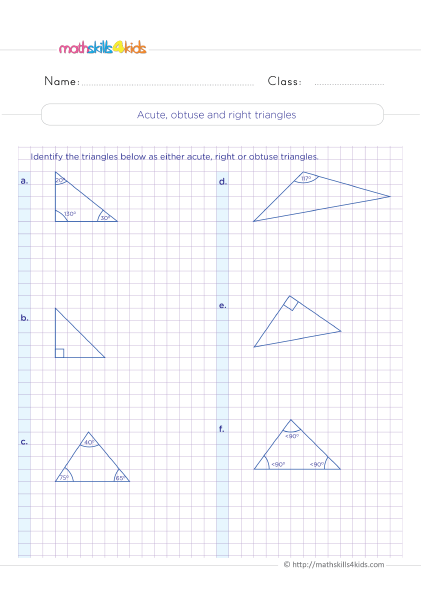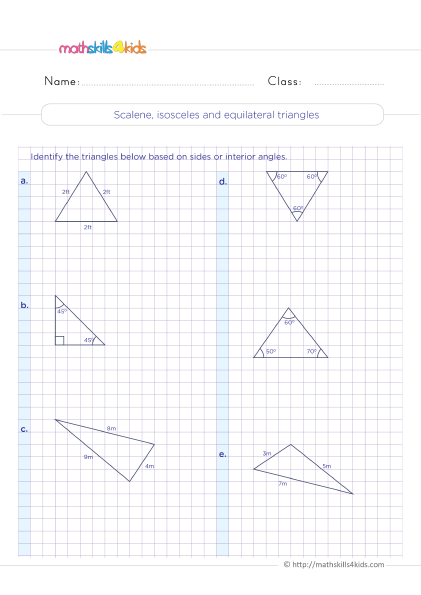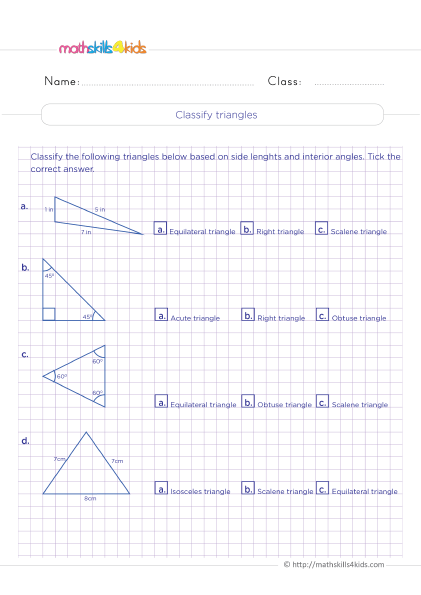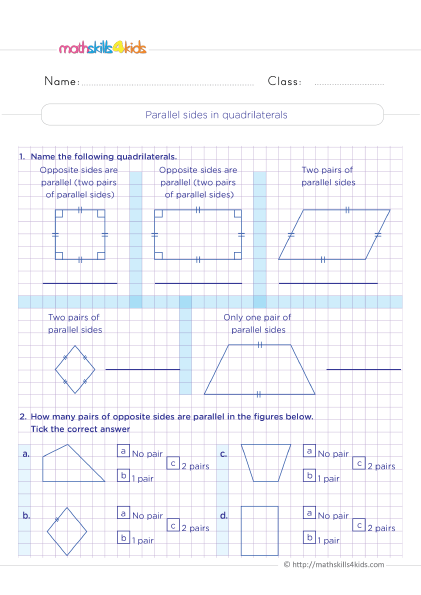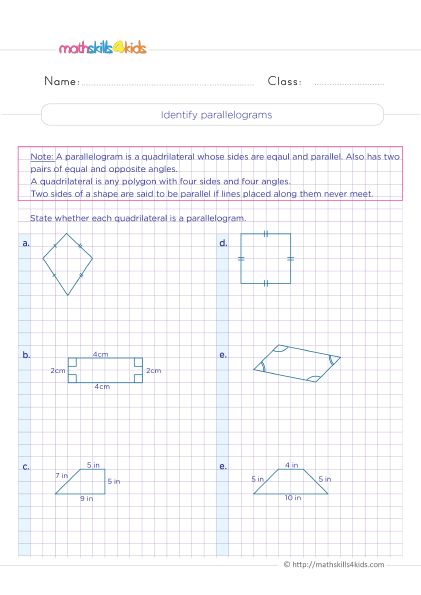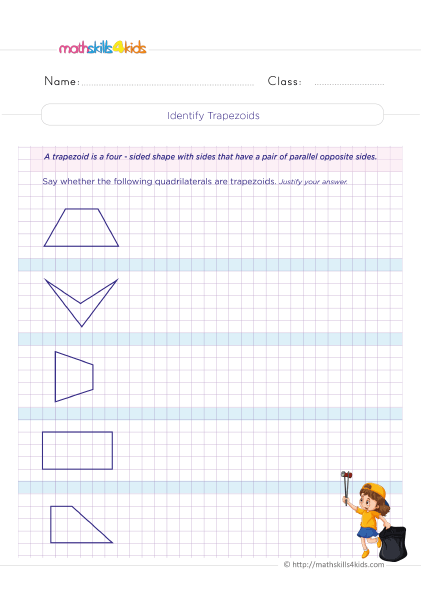Triangles and Quadrilaterals Worksheets for Grade 4: Geometry Made Easy
Are you ready to take your child's geometry skills to the next level? Look no further than our fun and interactive triangles and quadrilaterals worksheets designed specifically for Grade 4 students. This article aims to provide engaging activities to make learning geometry easy and fun.
-
These carefully crafted activities will make it easy for kids to grasp the properties and characteristics of triangles and quadrilaterals through hands-on exercises, colorful visuals, and engaging puzzles. By so doing, your child will develop a solid understanding of geometric concepts and enjoy the learning process.
From identifying different types of triangles to exploring the angles and sides of quadrilaterals, Mathskills4kids.com worksheets cover it. So, download these exciting worksheets now and help your child gain the confidence to tackle complex geometry problems and excel in math.
Triangles and Quadrilaterals: What they are and why they matter
Before diving into these worksheets, we will learn what triangles and Quadrilaterals are and why they matter. Triangles and quadrilaterals are two types of polygons.
Triangles are polygons with three sides and three angles. The word triangle comes from Latin and means "three angles.” Triangles can have different lengths of sides and different sizes of angles. Some triangles are equal on all sides and angles, while others are not.
Quadrilaterals are polygons with four sides, four angles, and four vertices. The word quadrilateral comes from Latin and means "four sides.” Quadrilaterals can also have different lengths of sides and different sizes of angles. Some quadrilaterals are equal on all sides and angles, while others are not.
Triangles and quadrilaterals are essential concepts in math and geometry learning because they help students develop a sense of logical classifications, create different shapes, and demonstrate how different figures are related.
-
BROWSE THE WEBSITE
-
DOWNLOAD FREE WORKSHEETS
-
-
4th GRADE MATH TOPICS
- Number sense
- Addition
- Subtraction
- Multiplication
- Division
- Mixed operations
- Variable expressions
- Functions
- Coordinate plane
- Data and graphs
- Logical reasoning
- Patterns and sequences
- Money math
- Units measurement
- Telling time
- Equivalent fractions
- Compare & order fractions
- Add & subtract fractions with like denominators
- Add & subtract fractions with unlike denominators
- Multiply fractions
- Decimals
- Add and subtract decimals
- Probabilities and statistics
- 2D shapes
- Triangles and quadrilaterals
- Symmetry
- Angles
- 3D shapes
- Geometric measurement
-
Buying is supporting us!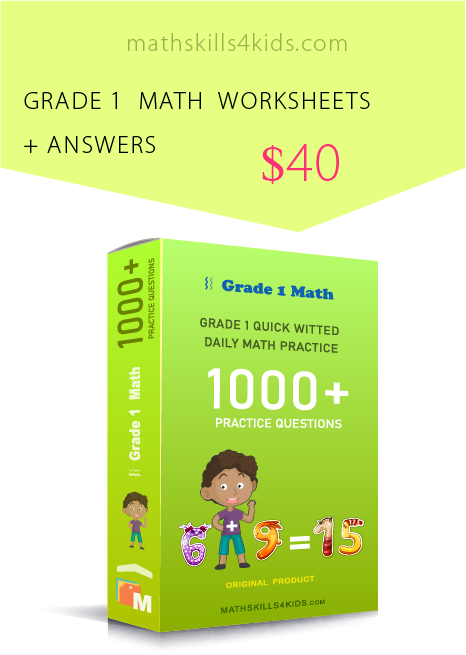
Buy Now...
-
-
Importance of Geometry in the Curriculum
Geometry is an essential branch of mathematics that plays a crucial role in our everyday lives. From understanding the shapes and structures of the physical world to solving real-world problems, geometry is a fundamental skill that students need to develop. Here are a few reasons why geometry is important in the curriculum:
1. Spatial Reasoning
Geometry develops spatial reasoning skills crucial for understanding and navigating the physical world. Students learn to visualize and manipulate objects in space by studying geometric shapes, enabling them to solve problems and make informed decisions.
2. Problem Solving
Geometry provides students with problem-solving skills that apply to various disciplines and real-life situations. The ability to analyze and reason geometrically helps students tackle complex problems, think critically, and make logical deductions.
3. Logical Thinking
Geometry promotes logical thinking by requiring students to follow a systematic and step-by-step approach to solving problems. Through deductive reasoning and the use of logical arguments, students develop analytical skills that are valuable in mathematics and beyond.
4. Career Opportunities
Geometry is a foundation for many careers, including architecture, engineering, computer graphics, and design. A strong understanding of geometric concepts opens up career opportunities for students, allowing them to pursue their interests and excel in their chosen fields.
By incorporating geometry into the curriculum and providing students with engaging worksheets, we ensure they develop the necessary skills and knowledge to succeed academically and in their future careers.
-
Benefits of using Mathskills4kids’ worksheets for learning geometry
Worksheets are an invaluable tool for teaching and learning geometry. They offer several benefits that enhance the learning experience and help students develop a solid foundation in geometry. Here are some of the key benefits of using Mathskills4kids’worksheets for learning geometry:
1. Hands-on Learning
Worksheets provide hands-on learning experiences that help students engage with geometric concepts practically and tangibly. Students develop a deep understanding of geometry and its applications by completing activities such as drawing shapes, measuring angles, and solving problems.
2. Visual Representation
Geometry can be an abstract subject, but Mathskills4kids’ worksheets visually represent geometric concepts through diagrams, illustrations, and colorful visuals. These visual aids make it easier for students to comprehend and remember geometric properties and relationships.
3. Interactive and Engaging
Our fun and interactive worksheets are designed to keep students engaged and motivated to learn. Students actively participate in their learning through puzzles, games, and interactive exercises, fostering a deeper understanding and enjoyment of geometry.
4. Reinforcement of Concepts
Worksheets provide ample opportunities for students to practice and reinforce their understanding of geometry concepts. Students solidify their understanding and build confidence in their geometry skills by repeatedly applying their knowledge in various exercises.
Using our worksheets to supplement classroom instruction, your child will reap the benefits of hands-on learning, visual representation, and interactive engagement, ultimately and easily mastering geometry.
-
Exploring different types of triangles
Triangles are three-sided polygons with unique properties and characteristics. Here are the different types of triangles your child will encounter in these triangles and Quadrilaterals Worksheets for Grade 4:
1. Equilateral Triangles
Equilateral triangles have three equal sides and three equal angles, each measuring 60 degrees. They are symmetrical and have rotational symmetry of order three. Equilateral triangles are found in various contexts, such as the faces of a pyramid or the shape of a traffic sign.
2. Isosceles Triangles
Isosceles triangles have two equal sides and two equal angles. The angles opposite the equal sides are also equal. Isosceles triangles often appear in architectural structures, such as the Eiffel Tower, where the legs of the tower form isosceles triangles.
3. Scalene Triangles
Scalene triangles have no equal sides or angles. Each side and angle of a scalene triangle is different. Scalene triangles are commonly found in irregular shapes, such as a lake's shoreline or a tree's branches.
Understanding the properties and characteristics of different triangles helps students identify and classify triangles accurately, laying the foundation for more advanced geometry concepts.
-
Properties of Triangles and their Applications
Triangles possess several unique properties and relationships essential for solving geometry problems. Here are some of the key properties of triangles and their applications:
1. Angle Sum Property
The sum of the interior angles of a triangle is always 180 degrees. This property allows students to calculate the measure of an unknown angle in a triangle by subtracting the sum of the known angles from 180 degrees. It also helps in classifying triangles based on their angle measures.
2. Pythagorean Theorem
The Pythagorean Theorem states that in a right-angled triangle, the square of the length of the hypotenuse (the side opposite the right angle) is equal to the sum of the squares of the other two sides. This theorem is widely used in various fields, such as engineering, construction, and navigation.
3. Similarity and Congruence
Triangles can be classified as similar or congruent based on their corresponding angles and side lengths. Similar triangles have the same shape but different sizes, while congruent triangles have the same shape and size. Similarity and congruence are essential for solving problems involving scale models, maps, and architectural blueprints.
By understanding the properties and applications of triangles, students develop critical thinking skills and the ability to apply geometric principles to real-world scenarios.
-
4th Grade-engaging classifying triangles worksheets
Our 4th-grade classifying triangles worksheets are designed to help students explore the various types of triangles and develop a comprehensive understanding of their properties. Through interactive exercises and engaging activities, these worksheets make learning about triangles enjoyable and effective.
1. Triangle Sorting
In this activity, students are presented with a set of triangles and are asked to sort them into different categories based on their properties. For example, they may be asked to sort triangles into equilateral, isosceles, or scalene categories. This exercise encourages students to analyze the properties of triangles and classify them accurately.
2. Triangle Construction
This worksheet challenges students to construct triangles based on given criteria, such as the length of the sides or the measures of the angles. By constructing triangles, students gain hands-on experience and a deeper understanding of the relationships between the sides and angles of triangles.
3. Triangle Puzzles
In this activity, students are presented with puzzles that require them to determine the missing properties of a triangle. For example, they may be given the measures of two angles and need to calculate the measure of the third angle. This exercise tests students' knowledge of triangle properties and helps them apply their understanding to solve problems.
Using these classifying triangles worksheets, your child will develop a thorough understanding of the properties and characteristics of triangles, enabling them to excel in geometry and problem-solving.
-
Properties of quadrilaterals and their real-world examples
Quadrilaterals are four-sided polygons with distinct properties and characteristics. Understanding these properties is vital for identifying, classifying, and applying quadrilaterals in real-world examples. Here are some of the key properties of quadrilaterals and their real-world applications:
1. Parallelograms
Parallelograms have opposite sides that are parallel and equal in length. They also have equal and opposite angles. Parallelograms are commonly found in architectural structures, such as door frames, windows, and fences.
2. Trapezoids
Trapezoids have one pair of parallel opposite sides. The non-parallel sides are called legs, and the parallel sides are called bases. Trapezoids are often encountered in everyday objects like tables, bridges, and road signs.
3. Rectangles
Rectangles have four right angles, making them ideal for creating square corners. They have opposite sides that are parallel and equal in length. Rectangles are widely used in construction, furniture design, and graphic design.
4. Squares
Squares are a special type of rectangle with all sides equal in length and all angles equal to 90 degrees. Squares are ubiquitous in our surroundings, from tiles on the floor to computer screens and picture frames.
Understanding the properties of quadrilaterals and their real-world examples enables students to identify and classify quadrilaterals accurately and apply this knowledge to practical situations.
-
Best tricks for identifying and classifying different types of quadrilaterals
A quadrilateral is a four-sided polygon. There are many types of quadrilaterals, such as squares, rectangles, parallelograms, rhombuses, trapezoids, and kites. How can you tell them apart? Here are some tips for identifying different types of quadrilaterals:
- A square is a quadrilateral with four equal sides and four right angles. A square is also a rectangle and a rhombus.
- A rectangle is a quadrilateral that has four right angles. A rectangle may or may not have equal sides. A rectangle is also a parallelogram.
- A parallelogram is a quadrilateral that has two pairs of parallel sides. A parallelogram may or may not have right angles or equal sides.
- A rhombus is a quadrilateral that has four equal sides. A rhombus may or may not have right angles or parallel sides. A rhombus is also a parallelogram.
- A trapezoid is a quadrilateral that has one pair of parallel sides. A trapezoid may or may not have right angles or equal sides.
- A kite is a quadrilateral with two pairs of equal adjacent sides. A kite may or may not have right angles or parallel sides.
To classify a quadrilateral, you can use these tricks:
- Look at the angles. If they are all right angles, they are either square or rectangular.
- Look at the sides. If they are all equal, it is either a square or a rhombus.
- Look at the parallel sides. If there are two pairs of parallel sides, it is either a square, a rectangle, a parallelogram, or a rhombus. If there is one pair of parallel sides, then it is a trapezoid.
- Look at the adjacent sides. If two adjacent sides are equal, it is a square, a rhombus, or a kite.
-
4th Grade fun classifying quadrilaterals worksheets for practicing
Quadrilaterals are four-sided polygons with distinct properties and characteristics. Our 4th-grade classifying quadrilaterals worksheets are designed to help students identify and classify different types of quadrilaterals. These worksheets provide a fun and engaging way for students to explore the world of quadrilaterals and develop a deep understanding of their properties.
1. Naming Quadrilaterals
In this worksheet, students are introduced to different types of quadrilaterals, such as squares, rectangles, parallelograms, and trapezoids. They are given various quadrilaterals and are asked to identify and name them based on their properties. This activity helps students familiarize themselves with the different types of quadrilaterals and their characteristics.
2. Sorting Quadrilaterals
This worksheet challenges students to sort a set of quadrilaterals into different categories based on their properties. For example, they may be asked to sort quadrilaterals into those with opposite sides parallel and those without. This activity reinforces understanding of quadrilaterals' properties and encourages critical thinking and classification skills.
3. Quadrilateral Puzzles
In this activity, students are presented with puzzles that require them to identify the missing properties of given quadrilaterals. They are given partial information about a quadrilateral, such as the lengths of its sides or the measures of its angles, and are asked to determine the missing information. This exercise helps students apply their knowledge of quadrilateral properties to solve problems and think analytically.
Using these classifying quadrilaterals worksheets, your child will become proficient in identifying and categorizing different types of quadrilaterals. The interactive nature of these activities will keep your child engaged and motivated to learn, making geometry an enjoyable subject.
-
Tips for effective geometry learning with triangles and quadrilateral worksheets for Grade 4
Learning geometry can be challenging for many students, but it can also be fascinating and rewarding with the right approach. Here are some tips to help your child make the most of our fun and interactive triangles and quadrilaterals worksheets for Grade 4:
1. Create a Positive Learning Environment
Set a positive tone for learning by creating a dedicated study area for your child. Ensure it's free from distractions and stocked with all the necessary materials, such as pencils, rulers, and coloring supplies. Encourage your child to approach geometry with a curious and open mindset, emphasizing that making mistakes is part of the learning process.
2. Encourage Hands-on Exploration
Geometry is a subject that lends itself well to hands-on learning. Encourage your child to explore geometric concepts beyond the worksheets. Please provide them with manipulatives, such as pattern blocks or tangrams, to help them visualize and understand the properties of triangles and quadrilaterals. This tactile approach can make abstract concepts more concrete and memorable.
3. Practice Regularly
Consistency is key to mastering any subject, and geometry is no exception. Encourage your child to practice geometry regularly, ideally briefly, each day. Our worksheets provide a variety of exercises that can be completed in small increments, making it easy to incorporate geometry practice into your child's daily routine.
-
Fun activities to practice your skills with triangles and quadrilaterals
Now that your students have learned how to identify and classify different quadrilaterals let's have some fun with them! Here are some fun activities that you can do at home or in the classroom to help your children practice their skills:
- Cut out different shapes from paper or cardboard and sort them into groups based on their properties. For example, you can sort them by the number of sides, the number of right angles, the number of parallel sides, or the number of equal sides.
- Use toothpicks and marshmallows to build different types of quadrilaterals. You can also use other materials like straws, pipe cleaners, or sticks. Try to make as many different types as possible and label them with their names.
- Draw different types of quadrilaterals on graph paper or a whiteboard. You can use a ruler to measure the lengths of the sides and the angles. You can also use a protractor to measure the angles. Check your answers with a partner or a teacher.
- Play online games that test your knowledge of triangles and quadrilaterals. For example, you have to shoot the shapes that match the given criteria. Or you can play Quadrilateral Quest by Math Goodies. Here you will drag and drop the shapes into the correct categories.
Bonus: More online resources to reinforce triangles and quadrilaterals learning for 4th graders
Apart from Mathskills4kids triangles and quadrilaterals worksheets for Grade 4, we will provide more resources to make geometry easy and fun. Here are some more online resources to reinforce triangles and quadrilaterals learning for 4th graders:
- Watch videos that explain the concepts and properties of triangles and quadrilaterals engagingly. For example, you can watch Quadrilaterals Song by Numberock (https://www.youtube.com/watch?v=1QW85kfakJc.), where you can sing along to a catchy song about the different types of quadrilaterals and their features.
- Read articles that provide more information and examples of triangles and quadrilaterals. For example, you can read Triangles by Math is Fun (https://www.mathsisfun.com/triangle.html.), where you can learn more about triangles' parts, angles, and areas. Or you can read Quadrilaterals by Math is Fun (https://www.mathsisfun.com/quadrilaterals.html.), where you can discover more about quadrilaterals' types, properties, and formulas.
- Take quizzes that assess your understanding of triangles and quadrilaterals. For example, you can take Triangles Quiz by Education Quizzes (https://www.educationquizzes.com/us/elementary-school-3rd-4th-and-5th-grade/mathematics/triangles/.), where you can answer multiple-choice questions about the basics of triangles. Or you can take Quadrilaterals Quiz by Education Quizzes (https://www.educationquizzes.com/us/elementary-school-3rd-4th-and-5th-grade/mathematics/quadrilaterals/.), where you can answer multiple-choice questions about the basics of quadrilaterals.
-
-
Thank you for sharing the links of MathSkills4Kids.com with your loved ones. Your choice is greatly appreciated.
Conclusion
Geometry is not only fun but also important for your future. Learning about triangles and quadrilaterals can help Grade 4 students develop their spatial reasoning, problem-solving, and logical thinking skills. These skills are useful for many careers, such as engineering, architecture, design, art, and more. So tell them not to fear geometry; they should rather embrace it!
We hope you enjoyed this article and learned something new. If you did, please share it with your friends and family. Remember to help your students practice their skills with triangles and quadrilaterals worksheets for Grade 4 from Mathskills4kids. You can also use other activities and resources that we suggested.
Have fun, and keep learning!
